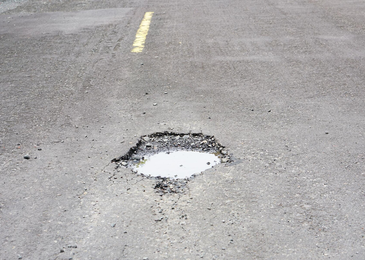How to drive through an open hatch without damaging the body, suspension and tires
- December 5, 2022
- 0
What to do if you come across an open hatch or a large hole in the road that you cannot avoid? An instinctive attempt to brake will not
What to do if you come across an open hatch or a large hole in the road that you cannot avoid? An instinctive attempt to brake will not

Most motorists are well aware of how to properly overcome a speed bump. Just before the front wheels hit this road safety element, you should press the brake pedal briefly but firmly. This will compress the front suspension and put the front wheels on the obstacle during the outbound stroke, significantly reducing the impact force. In addition, this technique works even when driving within recommended safe speeds. So there are no revelations here.
Another thing is when you are driving on a road or highway at high speed and suddenly encounter a “speed bump” of natural origin. For example an open hatch. Or a banal hole. It is curious that they often arise not only due to a defect in the road surface: they can be thawed spots in ice or rolled snow.
But if special signs warn us about approaching a speed bump, then a meeting with road defects is always unexpected. In this case, situations arise when the driver simply cannot avoid the contact of the wheels with the same open hatch. Simply because there are other cars to his left and right. What can be done to minimize possible damage to the suspension and bodywork?
If you are unable to dodge when you fall into a gap, instinctively resort to braking. This leads to the weight of the car being redistributed to the front wheels, which not only fall into the pit, but also crash very hard against the edge. Which is almost guaranteed to lead to the destruction of tires, rims, wishbones and even the power structure of the body. Not to mention the fact that this could cause the car to change direction abruptly, followed by an accident.
So what to do then? Oddly enough, but in no case should you slow down! In any case, the speed must remain the same. And so that the car does not suffer, you need to use the inertia of the body to unload the side of the car that is above the pit or open hatch. To do this, just before the front wheel of the car is in the pit, you need to turn the steering wheel briefly and sharply towards the obstacle! Moreover, with the instant return of the steering wheel to the “straight” position!
That is, if the pit is under the right wheel, we work with the steering wheel to the right! This will cause the weight of the car to be redistributed to the left side and the car – with the right side lifted up, so to speak – will painlessly overcome the obstacle. Obviously, the higher the speed of movement, the more effective this technique is.
However, much depends on the amplitude and speed of the steering wheel. In fact, it drives so fast that the car doesn’t even have time to change direction, it just leans in the opposite direction of the turn. Remarkable fact. When this technique was mastered by members of the USSR national motorsport team, with the correct taxi technique, the car passed through the open hatch at a speed of 30 km / h without any problems.
But in any case, the higher the speed, the more efficiently you can unload that side of the machine. So, if you come across an open hatch on the way and it is impossible to maneuver, the AvtoVzglyad portal recommends using this technique. True, it is desirable to learn the technique of its implementation under the guidance of an experienced instructor.



Most motorists are well aware of how to properly overcome a speed bump. Just before the front wheels hit this road safety element, you should press the brake pedal briefly but firmly. This will compress the front suspension and put the front wheels on the obstacle during the outbound stroke, significantly reducing the impact force. In addition, this technique works even when driving within recommended safe speeds. So there are no revelations here.
Another thing is when you are driving on a road or highway at high speed and suddenly encounter a “speed bump” of natural origin. For example an open hatch. Or a banal hole. It is curious that they often arise not only due to a defect in the road surface: they can be thawed spots in ice or rolled snow.
But if special signs warn us about approaching a speed bump, then a meeting with road defects is always unexpected. In this case, situations arise when the driver simply cannot avoid the contact of the wheels with the same open hatch. Simply because there are other cars to his left and right. What can be done to minimize possible damage to the suspension and bodywork?
If you are unable to dodge when you fall into a gap, instinctively resort to braking. This leads to the weight of the car being redistributed to the front wheels, which not only fall into the pit, but also crash very hard against the edge. Which is almost guaranteed to lead to the destruction of tires, rims, wishbones and even the power structure of the body. Not to mention the fact that this could cause the car to change direction abruptly, followed by an accident.
So what to do then? Oddly enough, but in no case should you slow down! In any case, the speed must remain the same. And so that the car does not suffer, you need to use the inertia of the body to unload the side of the car that is above the well or open hatch. To do this, just before the front wheel of the car is in the pit, you need to turn the steering wheel briefly and sharply towards the obstacle! Moreover, with the instant return of the steering wheel to the “straight” position!
That is, if the pit is under the right wheel, we work with the steering wheel to the right! This will cause the weight of the car to be redistributed to the left side and the car – with the right side lifted up, so to speak – will painlessly overcome the obstacle. Obviously, the higher the speed of movement, the more effective this technique is.
However, much depends on the amplitude and speed of the steering wheel. In fact, it drives so fast that the car doesn’t even have time to change direction, it just leans in the opposite direction of the turn. Remarkable fact. When this technique was mastered by members of the USSR national motorsport team, with the correct taxi technique, the car passed through the open hatch at a speed of 30 km / h without any problems.
But in any case, the higher the speed, the more efficiently you can unload that side of the machine. So, if you come across an open hatch on the way and it is impossible to maneuver, the AvtoVzglyad portal recommends using this technique. True, it is desirable to learn the technique of its implementation under the guidance of an experienced instructor.
Source: Avto Vzglyad
Donald Salinas is an experienced automobile journalist and writer for Div Bracket. He brings his readers the latest news and developments from the world of automobiles, offering a unique and knowledgeable perspective on the latest trends and innovations in the automotive industry.